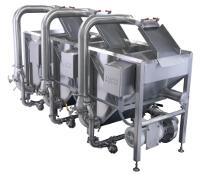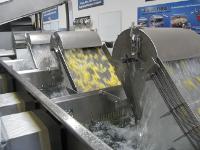Many processes in food manufacturing can be addressed to reduce operating costs while at the same time improving sustainability. One of the most critically important objectives is reducing process energy and water consumption. Implementing energy- and water-efficient practices and technologies should be a senior priority at system levels in food manufacturing plants. With the continual increase in energy and water costs, optimizing energy and water usage in food processing has never been a stronger issue.
Reducing energy and water usage in industrial manufacturing, including food processing, is a key focal point of the U.S. Dept. of Energy’s sustainability initiatives. The Department’s Energy Star and Industrial Technologies programs address process functions in manufacturing plants that utilize steam, compressed air, process heat, electric and other systems that could potentially be a source of wasted energy and natural resources. These programs put particular emphasis on new technologies to achieve energy sustainability.

Embracing these sustainability initiatives is the continuous-process cooking and cooling method for pasta, rice, and vegetables. This process has experienced continual technology improvements over the past four decades in reducing energy consumption through improved system designs and streamlined automation. Recent technological advances in continuous-process cooking and cooling have made significant improvements in reaching critical energy and water efficiency levels. (Shown right, Easy-Flow multi-stage quench system feom Lyco Manufacturing.)
Continuous-Process Cooking and Cooling
Continuous-process cooking and cooling evolved from the batch method, which has been a standard in commercial cooking and cooling systems. But the batch method has its drawbacks. It is somewhat limited in maintaining precise temperature and time parameters of the pasta, rice, or vegetable food products in the cooking and cooling process. The batch process is also limited in its agitation capability to keep these products separated during the cook and chill processes, which facilitates consistent product temperatures.
The first generation of continuous-process cooking/cooling systems used conveyors to move food products through the processes in series. Cookers and coolers are only as good as their ability to precisely control the product’s exposure to time and temperature parameters throughout the processes. Conveyor-based systems, however, are prone to variable production rates, which introduces variations in product temperature resulting in inconsistent product quality.
These conveyor-based systems have been superseded by rotary drum continuous-process cooker/coolers, which use an auger method to move food products through an enclosed, water-filled drum. Considered the industry standard, rotary drum cooker/coolers have significantly improved the processing of pasta, rice, and vegetables.
These improvements have ensured more uniform processes and handling of even higher throughputs. Step-blanching, for example, enables incremental temperature increases to be made throughout the process. Gentle mechanical agitation can be imparted to the food products as they progress through the cook and chill processes. A system called Hydro-Flow™, from Lyco Manufacturing, applies a combination of air and water injection, which physically and buoyantly supports heavier loads, more evenly distributing food products in cookers and coolers.
Controls automation integrated into rotary drum continuous-process cooker/cooler systems has largely made these improvements possible. Their PLCs provide precise automated control of process functions, including recipe management, and enable uniform cooking temperatures and control of water flow, achieving a totally consistent end process. These control systems minimize the time required to perform complex tasks and increase efficiency in cooking and cooling process operations. They reduce operator error and process cycle times, enable improvement in product quality and consistency, and increase production throughput and equipment ROI.
These automated process technologies have also minimized energy and water consumption. Compared to batch systems and conveyor-based cooker/coolers, the latest improvements in rotary drum continuous-process systems enable them to process the same volume of pasta, rice, or vegetables in less time, using significantly less energy to heat the water required for the processes. Monitoring energy and water usage, and managing process systems in these rotary drum cookers and coolers has played an important role supporting sustainability efforts in food processing plants.
Recapturing Heat and Water from Cooker Overflow
With conventional rotary drum continuous-process cooking, the cooker is filled with ambient-temperature (approximately 65°F) water and heated to 200 to 205°F. During processing, the water needs to be continually heated to compensate for the constant addition of ambient-temperature product. This requires energy.

Additionally, because water is absorbed into the products during cooking of pasta and rice, ambient-temperature makeup water needs to be continually added into the rotary drum. This adds to the heat load requirements of the cooker and also requires energy. (Shown right, pasta run with Easy-Flow multi-stage quench system.)
During a process run of pasta, rice, or starchy vegetables, which may continue for 20 continuous hours, as much as 10 gal of water can be overflowed per minute to reduce the buildup of starch in the water. This means an equal amount of makeup water needs to be added. The volume of overflow and makeup water varies depending on the size of the cooker, and the type and volume of pasta, rice, or vegetables being run.
The overflow water is discarded as wastewater, and is taking the 200 to 205°F heat energy out along with it. For every gallon that comes out of the cooker at 200 to 205°F as overflow, a gallon of makeup tap water at approximately 65°F needs to be added. The cooker, then, has to heat that water back up to 200 to 205°F to continue the cook process. This requires energy.
In essence, not only is the overflow heat energy from the cooker being wasted, but new energy now has to be added to reheat the water.
The latest technology in continuous-process rotary drum cooking now captures and reuses heat from the overflow water. Instead of being put down the drain, the overflow water that leaves the cooker is moved to an adjacent storage tank where it is pumped through a heat exchanger. The heat is transferred from the hot overflow water to a reservoir of ambient-temperature makeup water waiting to be put into the cooker. With this process, the makeup water can reach 125°F, considerably higher than the approximately 65°F tap-originated makeup water used in all prior continuous-process cooker systems. This significantly reduces the heating load requirements of the cooker.
A sizable difference in energy savings can be realized when heating water to 200°F from a starting point of 125°F, rather than from 65°F.
Additionally, the starch-laden overflow water, which had previously been discarded, is then screened to remove the particulates and reused as makeup water to compensate for product absorption, providing significant water savings.
This system was developed by Lyco Manufacturing, manufacturer of commercial rotary drum continuous-process cooking and cooling equipment. The new technology can be integrated into existing rotary drum continuous-process cooking lines. The upgrade can pay for itself, in energy savings alone, within a 6-month timeframe.
Energy Recuperation from the Quench System
In rotary drum cooking and cooling, the pasta, rice, or vegetables come out of the cooker at 200 to 205°F. The product then immediately goes into a chiller where it is cooled in 35 to 40°F water. Initially, tap water with a temperature of about 65°F goes into the chiller. To bring the chiller’s water temperature down to the 35 to 40°F range needed for cooling product, energy has to be expended.
As hot food products are released into the chiller, the water has to be continually cooled to take the heat out of the product and bring its temperature down to a safe 40°F range quickly, to reduce the potential of bacterial growth. This requires energy.
Bacteria predominantly grow in an environment that is between 40 and 140°F. During the cooking process, raw ingredients are brought up past 140°F as quickly as possible to the final cooking temperature, thus minimizing the time that food products can be influenced by bacterial growth. The same is true on the other end of the process line, with the cooling of the product – reducing its temperature as quickly as possible to below 40°F is essential.
The energy usage in this cook-and-cool process has been considerably improved upon with the addition of a mid-process quench step, adding a small reservoir between the cooker and the cooler.
Instead of moving the product directly from the 200 to 205°F water temperature of the cooker and into the 35 to 40°F chiller water, a mid-process quench cycle with unheated ambient-temperature tap water (65°F) can capture much of the product’s heat before it enters the primary chill cycle. Since the quench tap water is not preheated, it requires no energy input.
Quenching reduces the temperature of the pasta, rice, or vegetables down to 110 to 120°F, capturing 45 to 50% of the cooked product’s heat energy in the quench water. The 110 to 120°F water in the quench can then be used in the cooker for makeup water to rehydrate the product, instead of bringing in the usual 65°F tap water to reach the 200 to 205°F temperature cooking range. This sizably reduces the energy draw normally needed to heat the cooker water.
The quench then releases the product into the chiller, which now only has to bring the product temperature down 70 to 80 deg to reach the targeted 40°F, instead of 160 to 165°F if the quench cycle was not in place. The energy savings in the chiller from the reduced refrigeration load is significant.
Also developed by Lyco Manufacturing, the Easy-Flow® quench system maintains 100% uniform product cooling with less than 1% product damage. Rice, most varieties of pasta, and select vegetables can be cooled in the quench to 110 to 120°F before entering the chilled water cooler.
Easy-Flow uses a patented plenum technology to achieve its high-speed cooling without damaging the product. The pasta, rice, or vegetables are pulled through the cooling plenum at the bottom of the tank by Venturi effect, which increases the velocity of the fluid without pump impeller contact. The Venturi effect creates a pressure differential that pulls the water and product through at a high speed with the capability of moving 300 gal of water and product through the plenum per minute.
Reduced Energy and Water Consumption
Compared to conventional rotary drum continuous-process cooking, recapturing heat and water from cooker overflow and quench systems can result in considerable savings.
When recapturing heat and water from cooker overflow, BTUs can be reduced by 60%, kWh by 72%, and water usage can be reduced by 25%. With the quench system in place, for a continuous-process rotary tank cooker, BTUs and kWh can be reduced by 35% compared to an identical rotary tank cooker without the quench system. For the chiller under the same conditions, with the quench system in place, BTUs, tons of cooling required per hour, and kWh can be reduced by 41%.
These recent technological advances in continuous-process cooking and cooling have allowed food processors to significantly reduce their energy and water consumption, while achieving improved equipment and process ROI.





